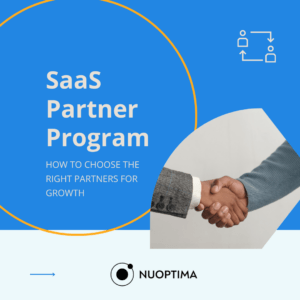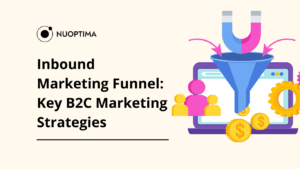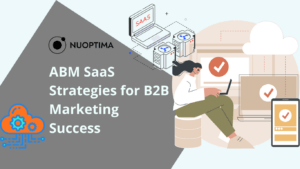Introduction
The pitch deck is a vital tool in the competitive landscape of B2B SaaS (software as a service). It’s more than just a pretty presentation; it should capture and portray a company’s vision, bridging the gap between the SaaS business and potential stakeholders.
This article examines the intricacies of crafting a compelling B2B SaaS pitch deck. From understanding its core components to exploring best practices, our B2B SaaS SEO agency will show you how to create a winning pitch deck that informs and inspires.
The Main Purpose of a Pitch Deck
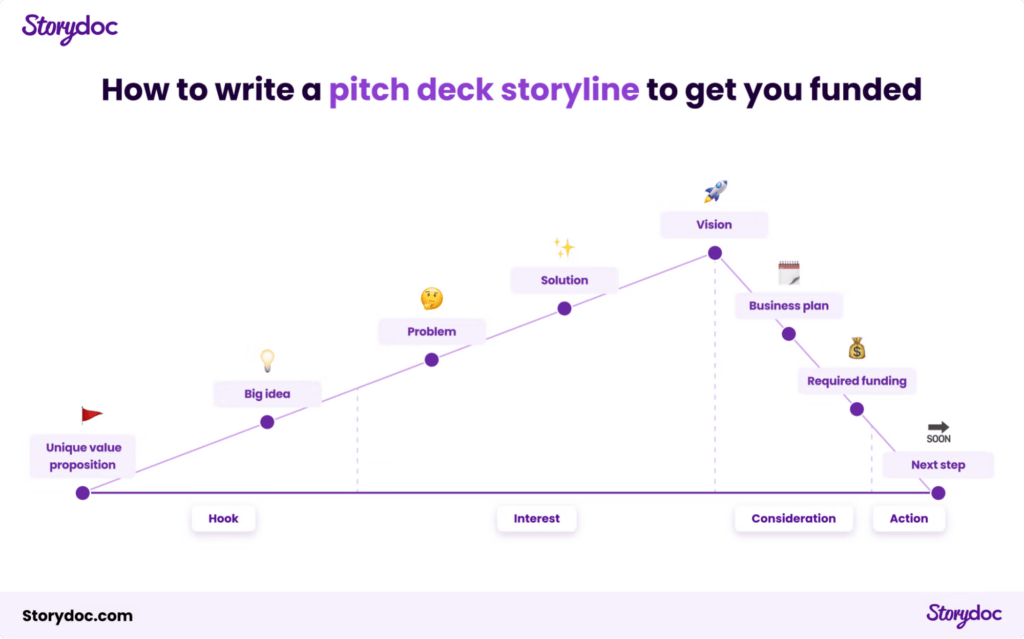
A pitch deck is a visual presentation designed primarily for startups and enterprises to provide their audience (often potential investors) with a quick snapshot of their business plan. While it might seem like a straightforward document to some, the underlying purpose of a pitch deck goes beyond a simple representation.
At the heart of a pitch deck lies the narrative of a startup’s journey, its vision, and the challenges it aims to address. It serves as a way of sharing the startup’s value proposition in a concise and compelling way. For those in the B2B SaaS sector, where the competition is intense, and the audience is clued up, a pitch deck becomes an indispensable tool to convey complex ideas and business models.
A pitch deck’s primary role is to pique potential investors’ interest. It’s the first step in a series of interactions to secure further discussions and potential investment. A well-structured pitch deck provides information and tells a story, making it easier for investors to understand and relate to the startup’s mission.
B2B SaaS Pitch Deck Summary Table
Though a pitch deck may seem to be merely a collection of slides, when employed skillfully, it becomes a strategic instrument that can unlock opportunities and partnerships, particularly in the B2B SaaS industry.
Here is a summary table of the main purposes of a pitch deck:
| Purpose | Description |
| Engaging Introduction | To provide a compelling introduction to the startup’s core idea and the team driving its vision. |
| Problem Identification | To highlight the specific market gaps or challenges that the startup aims to address. |
| Solution Proposition | To demonstrate how the startup’s product or service offers a viable solution to the identified problem. |
| Market Analysis | To give insights into the market’s potential size, growth trajectory, and competitive landscape. |
| Value Proposition | To convey the unique benefits and advantages the startup offers, setting it apart from competitors. |
| Financial Overview | To present a snapshot of the startup’s current financial health and future projections. |
| Call to Action | To encourage potential investors or partners to take the next steps, be it discussions, trials, or investments. |
8 Key Elements of an Effective B2B SaaS Pitch Deck
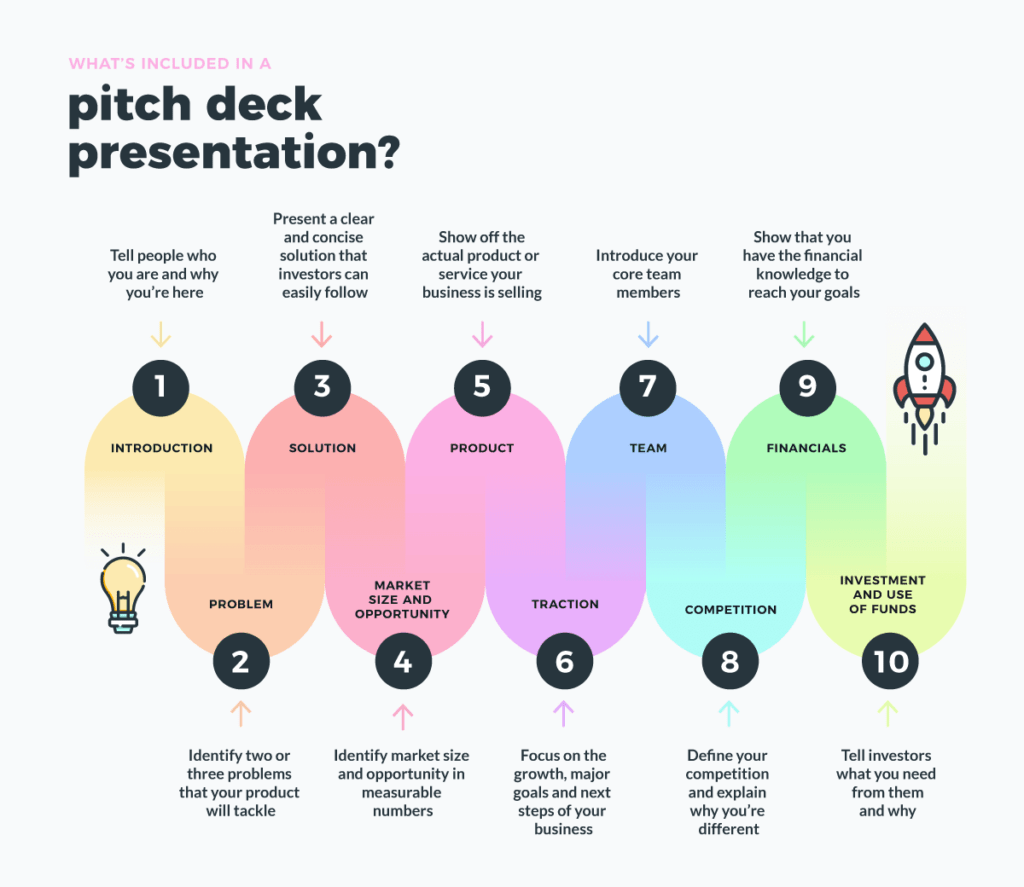
Here are eight key elements every pitch deck should include, along with some B2B SaaS examples:
1. Problem Statement
In B2B SaaS, understanding the challenges businesses face is paramount. An effective pitch deck begins by pinpointing a specific market gap or issue the SaaS offering seeks to resolve. This is not just about stating a problem but also about illustrating its magnitude. By quantifying the problem’s repercussions on businesses or entire industries, startups can underscore the urgency and significance of their offering.
Example: Slack

Slack identified a principal issue in modern workplaces: fragmented communication. Teams were using multiple platforms for chats, emails, and file-sharing, leading to decreased productivity and missed messages. Slack’s pitch deck would have highlighted this disjointed communication landscape, emphasising the inefficiencies and potential for errors.
2. Solution Overview
Once the problem is laid out, the next step is to present the remedy. This section delves into how the SaaS product or service resolves the previously identified issue. More than just a list of features, it’s vital to highlight the USPs that make the solution viable and preferable.
Example: Dropbox

Dropbox presented a simple yet effective solution to the problem of file storage and sharing. Instead of relying on emails or physical storage devices, Dropbox offered cloud-based storage that allowed users to access their files from anywhere, on any device. Their USP was the seamless syncing of files across devices and easy sharing capabilities.
3. Market Analysis
A thorough understanding of the market is essential for any startup. This involves presenting figures like the Total Addressable Market (TAM), the Segmented Addressable Market (SAM), and the Segmented Obtainable Market (SOM). Additionally, offering insights into the existing competitive environment can demonstrate awareness and preparedness.
Example: Zoom

Before its massive adoption, Zoom would have analysed the video conferencing market, noting major players like Skype and WebEx. Their market analysis would have shown a growing need for reliable video communication tools, especially for businesses with remote teams or global operations.
4. Product Demonstration
While words can convey a lot, showing is often more impactful than telling. This section should visually represent the product’s primary features and functionalities. Moreover, incorporating testimonials and case studies can provide real-world evidence of the product’s efficacy and value.
Example: Asana

Asana, a task and project management tool, would showcase its intuitive user interface during product demonstrations. By walking potential investors or clients through the process of creating jobs, assigning team members, and tracking progress, Asana could effectively demonstrate its value proposition.
5. Company Differentiators
Every company has a story, and this narrative can be a powerful tool in distinguishing oneself from the competition. Sharing the company’s origins, journey, and distinct marketplace can resonate with potential investors. Furthermore, any technological advancements or specific advantages should be highlighted here.
Example: HubSpot

HubSpot stands out in the crowded CRM and marketing automation space by promoting its ‘inbound marketing’ philosophy. Their platform isn’t just about managing contacts; it’s about attracting, engaging, and delighting customers. This holistic approach to marketing and sales sets them apart from traditional CRM tools.
6. Financial Health and Projections
This section offers a glimpse into the startup’s financial trajectory, helping potential investors gauge the viability and potential return on investment. Present the projected sales figures for the next three years, a profit and loss statement, and a cash flow projection. Utilise clear charts to depict monthly or yearly growth, ensuring that the figures are easily digestible. It’s also essential to accompany these figures with a brief discussion of the assumptions that informed these projections. Whether it’s based on market research, past performance, or industry benchmarks, being transparent about the basis of these figures can instil confidence in potential investors.
Example: Atlassian

Atlassian, known for its collaboration tools like Jira and Confluence, astutely presented its financial information during its IPO process. The company emphasised its strong customer base, which included a significant portion of Fortune 500 companies, indicating a trusted and widely adopted platform. Atlassian also highlighted its unique sales model, which relied less on a traditional sales team and more on organic growth, leading to lower customer acquisition costs. By showcasing a combination of steady revenue growth, high customer retention rates, and efficient operational costs, Atlassian successfully conveyed its robust financial health and future potential to investors.
7. Credibility Indicators
Trust is a cornerstone in the investment world. Introducing key team members, their backgrounds, and areas of expertise can bolster the company’s credibility. Additionally, mentioning any esteemed advisors or board members, along with relevant KPIs, can further solidify the company’s standing in the eyes of potential investors.
Example: Salesforce
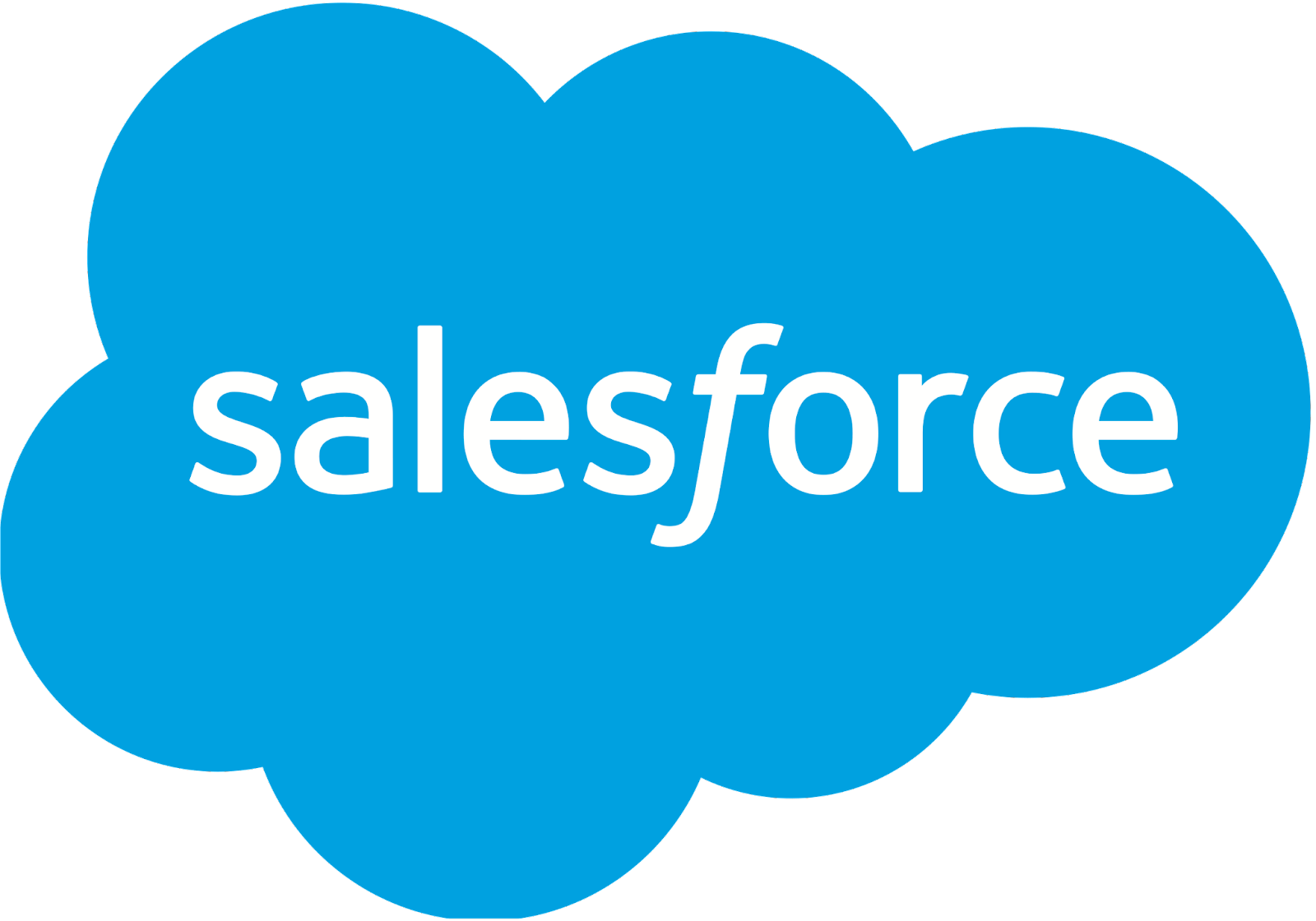
Salesforce, a leading CRM platform, boasts its founder Marc Benioff’s background, who previously had a significant tenure at Oracle. The company also highlights its partnerships with major global brands and showcases impressive growth metrics to establish its dominance in the CRM space.
8. Investment and Growth Strategy
Lastly, a clear outline of how the startup plans to utilise potential investments is crucial. This involves not only immediate use but also a longer-term roadmap detailing plans for scaling, entering new markets, or refining the product. By providing a clear trajectory, startups can assure investors of their vision and direction.
Example: DocuSign

DocuSign, an electronic agreement service, laid out plans to expand its product offerings and enter new markets. Their growth strategy would have highlighted the shift towards digital transactions and the potential to integrate with other major platforms, ensuring electronic agreements become the norm in various industries.
Design and Presentation Tips for B2B SaaS Pitch Decks
The design and presentation of a pitch deck can significantly influence its reception. While the content is undoubtedly vital, the manner in which it’s presented can either captivate or alienate the audience. Here are some key considerations to ensure your pitch deck resonates effectively with its intended audience.
Visual Appeal and Clarity
The human brain processes visuals much faster than text. Therefore, integrating clear and appealing visuals can aid in conveying complex information swiftly and effectively. However, it’s essential to strike a balance. Overloading slides with graphics can be as detrimental as text-heavy slides. Use visuals that complement and enhance the narrative, ensuring they’re relevant and add value to the content. A clean layout, consistent colour scheme, and legible fonts can make the deck both aesthetically pleasing and easy to follow.
The Art of Storytelling
Every successful pitch tells a story. Starting with the problem, moving through the solution, and culminating in the potential for future success, a pitch deck should take the audience on a journey. This narrative approach not only makes the content more engaging but also aids in retention. Remember, facts tell, but stories sell. By weaving a compelling narrative around the SaaS product or service, you can evoke emotions and make a lasting impression.
Tailoring the Pitch for Different Investors
Not all investors are the same. While some might be interested in the technical aspects of the SaaS product, others might be more focused on the financial projections or market dynamics. It’s crucial to understand the background and interests of the investors you’re pitching to. For instance, if presenting to investors with a deep understanding of the SaaS industry, it might be beneficial to delve into finer product details. Conversely, for those with a more general investment background, a broader overview with an emphasis on market potential and financials might be more appropriate.
Design Tools
Some B2B SaaS companies can spend days or even weeks designing an attractive pitch deck. There are some great tools out there to help you pull together an attractive and professional pitch deck. Here are some of our favourites so you can spend more time focusing on the content rather than the design:
| Tool Name | Key Features | Pricing | Best For |
| PowerPoint | Versatile slide creationWide range of templatesIntegration with other Microsoft products | Part of Microsoft Office Suite (from £59.99/year) | Good for those already using Microsoft products |
| Keynote | Intuitive design interfaceSeamless integration with Apple productsHigh-quality animations | Free with Apple devices | Mac and iPad users looking for a polished finish |
| Canva | User-friendly drag-and-drop interfaceExtensive library of templatesCollaborative features | Free basic version; Pro version at £8.99/month | Startups and SMEs looking for a quick and visually appealing deck |
| Prezi | Non-linear presentationsZoomable user interfaceCloud-based | Starts at £3/month for Basic; Business plans available | SaaS companies looking to create dynamic and interactive presentations |
| Slidebean | AI-powered designCurated templates for startupsContent-first approach | Starts at £8/month | Startups and entrepreneurs that want a streamlined design process |
| Visme | Infographics and business-centric templatesInteractivity featuresData visualisation tools | Starts at £10/month | Businesses focusing on data-driven presentations |
Common Mistakes to Avoid in B2B SaaS Pitch Decks
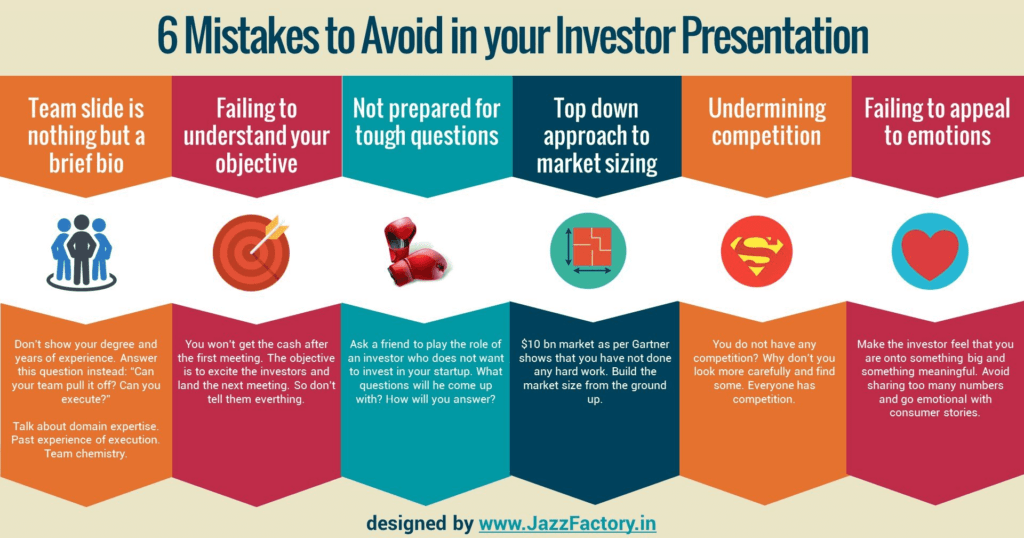
Crafting an effective pitch deck is as much about knowing what to include as it is about recognising what to avoid. While a well-constructed pitch deck can open doors to invaluable opportunities, certain missteps can diminish its impact or even turn potential investors away. Here are some common pitfalls to be wary of:
Overloading Slides with Information
A pitch deck should be a concise representation of a startup’s vision, not an exhaustive document. Bombarding the audience with excessive information can dilute the main message and complicate the presentation. Each slide should convey a singular, clear idea. If it is cluttered with text or graphics, it’s a sign that the information needs to be streamlined or spread across multiple slides. Remember, simplicity often leads to clarity.
Neglecting Potential Concerns or Objections
While it’s natural to want to present the business in the best light, it’s equally important to anticipate and address potential concerns. Investors will likely have reservations or questions about the business model, competition, or market dynamics. By proactively addressing these issues in the pitch deck, startups demonstrate foresight and preparedness. It’s a way of showing that the business has considered various scenarios and is equipped to navigate challenges.
Overlooking Pitch Delivery Practice
The content of a pitch deck is undeniably crucial, but so is the manner of its delivery. A pitch is as much a performance as it is a presentation. Without adequate practice, even the most well-crafted deck can fall flat. It’s essential to rehearse the pitch multiple times, refining the delivery, ensuring smooth transitions between slides, and preparing for potential questions. Practising in front of a varied audience, such as colleagues or mentors, can provide valuable feedback and help identify areas for improvement.
How to Present a Pitch Deck to Potential Investors
Pitching to potential investors is a pivotal moment for any B2B SaaS business. It’s an opportunity to showcase the value proposition, growth potential, and the team behind the venture. Here are some essential tips to ensure your pitch resonates effectively with potential investors:
First Impressions Matter
- Initial Approach: The beginning of your pitch sets the tone. Ensure you’re well-prepared and confident.
- Engage Actively: As you delve deeper into your presentation, maintain clarity and enthusiasm.
- Conclude Strongly: The closing moments should reinforce your key messages and leave a lasting positive impression.
Introduce Yourself Effectively
- Build Rapport: Engage with your audience from the outset. Find common ground and ascertain their level of knowledge.
- Show Genuine Passion: Convey enthusiasm about your idea, team, and sector. Authentic passion is a differentiator.
- Remain Authentic: Investors are not just investing in an idea but also in the people behind it. Ensure you come across as sincere.
Elevator Pitch Essentials
- Keep It Brief: An elevator pitch should be concise yet impactful. It’s about capturing interest quickly.
- Structure It Well: Start with the need or problem, present your solution, and conclude with the benefits.
- Engage the Listener: Ensure your pitch is relatable and resonates with the listener’s interests or pain points.
Presentation Structure
- Start With a Headline: Begin your presentation with a compelling headline or statement that encapsulates your pitch.
- Organise Clearly: Break your presentation down into sections or chapters for clarity.
- Engage and Persuade: Use persuasive points throughout to reinforce your message and make it memorable.
Understand Your Audience
- Research Thoroughly: Know who you’re pitching to. Understand the firm’s background and investment history.
- Identify Key Players: Recognise the decision-makers in the room and tailor your pitch to address their interests.
- Anticipate Questions: Prepare for potential questions or objections to ensure a smooth presentation.
Keep It Simple and Relatable
- Avoid Overloading: Focus on key points, avoiding unnecessary jargon or overly technical details.
- Use Stories: Narratives can make your pitch more relatable and memorable.
- Stay Audience-Centric: Ensure your content is tailored to the interests and needs of your audience.
Post-Presentation Actions
- Get Feedback: After your pitch, gather feedback to refine future presentations.
- Follow Up: Engage with potential investors post-presentation to address any further queries.
- Reflect and Refine: Use the experience to refine your pitch strategy and content for future opportunities.
A successful pitch to investors is a blend of preparation, passion, and understanding of your audience. By following these tips, B2B SaaS businesses can enhance their chances of securing valuable investments and SaaS partnership strategies.
Other Uses for a Pitch Deck Beyond Attracting Investors
While the primary purpose of a B2B SaaS pitch deck is often to secure investment, its benefit extends beyond this one goal. A well-constructed pitch deck can serve multiple functions in the lifecycle of a startup or established business. Here are some examples of additional uses:
- Onboarding New Employees: A pitch deck provides a succinct overview of the company’s mission, vision, and objectives. Using it during the onboarding process can help new team members quickly grasp the company’s ethos, its products, and the market it serves, ensuring they align with the company’s goals from the outset.
- Securing Partnerships: When seeking to form strategic alliances or partnerships, a pitch deck can be an invaluable tool. It offers potential partners insight into the company’s value proposition, demonstrating how a collaborative effort could be mutually beneficial.
- Product Launches: A pitch deck can also come into play when introducing a new product or feature to the market. A modified version of the document can be used to highlight the benefits and functionalities of the new offering, making it easier for potential users or clients to understand its value.
- Internal Reviews and Strategy Sessions: Regularly revisiting the pitch deck during internal meetings can help realign the team’s focus, ensuring everyone remains on the same page regarding the company’s direction and objectives.
- Engaging With Media and Analysts: For startups looking to gain media coverage or attention from industry analysts, a pitch deck can offer a concise overview of the company, making it easier for these stakeholders to understand and relay the company’s story.
How a Growth Agency Can Help
While a B2B SaaS business might have a groundbreaking product, effectively conveying its potential takes practice and skill. A growth agency, with its expertise in storytelling, design, and market research, can be the guiding hand that ensures the pitch deck not only informs but also impresses and persuades.
Here are some of the key areas an expert SaaS growth agency can help:
- Strategic Storytelling
- Data Presentation
- Design Expertise
- Market Research
- Feedback Loop
- Training and Rehearsal
- Customisation for Audience
In addition to the points above, knowing where or how to get your pitch deck out there for maximum impact can be a minefield. NUOPTIMA helps B2B SaaS companies with such problems and can assist you in reaching your investor goals and company expansion targets. We have worked with B2B SaaS companies such as Quolum and Zelt in their growth journeys. With our support, they are now achieving fantastic results in their marketing efforts and have more business software subscribers than ever before.
You can trust our team to have the experience and knowledge needed to navigate the evolving B2B SaaS market. Book a free discovery call to talk through your growth strategy.
Closing Thoughts
In the journey of a B2B SaaS startup marketing, the pitch deck stands as a pivotal tool, bridging the gap between vision and realisation. Its significance extends beyond mere presentation; it reflects a startup’s aspirations, solutions, and potential value to investors and stakeholders. A meticulously crafted pitch deck conveys information and tells a compelling story, making it easier for potential partners to understand and align with the startup’s mission.
However, the business landscape is fluid, with shifting challenges and emerging opportunities. As such, startups need to view their pitch decks as living documents. Regular refinement, informed by feedback and evolving market conditions, ensures the deck remains relevant and resonant. This is where the expertise of a specialized SaaS PR agency becomes invaluable. By leveraging their insights and experience, startups stay prepared for new investment opportunities and demonstrate adaptability and a keen understanding of the market in which they operate.
While the initial creation of a pitch deck is a significant milestone, its ongoing evolution is what truly determines its lasting impact. Therefore, B2B SaaS companies are encouraged to approach their pitch decks with diligence and adaptability, ensuring they remain a powerful tool in their growth journey.
FAQ
A B2B pitch deck is a concise presentation used primarily by startups (often in the SaaS sector) to showcase their company, product, or service to potential investors, partners, or clients.
A SaaS pitch deck should encompass the problem statement, solution overview, market analysis, product demonstration, company differentiators, credibility indicators, and investment and growth strategy.
To craft a SaaS pitch deck, start by understanding your target audience and then outline your narrative. Use a clean design, incorporate key elements like the problem you’re solving, your solution, and market potential, and ensure clarity and conciseness in your content.
Investors seek a clear value proposition, evidence of market demand, a sustainable competitive advantage, details about the team’s background and capabilities, and a coherent financial and growth strategy in a pitch deck.
Yes, pitch decks are typically highly visual to ensure they effectively convey complex information in an engaging and easily digestible manner, aiding in comprehension and retention.
